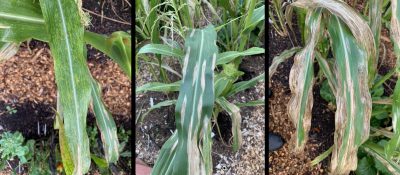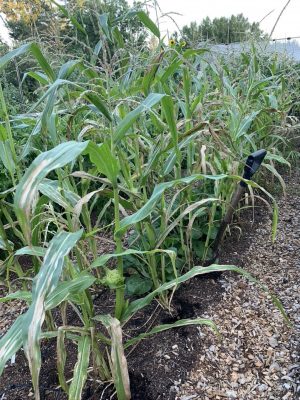SICKNESS, MY CORN NOT ME
An Interesting Puzzle Unfolds
Sudoko and Scrabble and other games and puzzles offer endless hours of entertainment and stimulation. Or so I hear. I get those challenges and rewards from my garden. Case in point is a bed of sweet corn which has been stunted all season long and then last week, almost suddenly, all the plants’ leaves turn sickly as well. Needless to say, ears are developing poorly or not at all. Why, I asked?
I have to backtrack. Each year I plant 4 beds of corn, each about 20 feet long, which supplies plenty of ears for fresh eating and freezing. I spread out the harvest season by planting a new bed every two weeks after the previous planting. Each bed, like other beds in my vegetable gardens, is spread each year with a one-inch depth of compost to maintain fertility (as well as other benefits).

At first I thought perhaps there was a fertility problem with the stunted bed. But, as I wrote, all the beds get the same fertility treatment. Watering is also the same, via drip irrigation. And early-season Chinese cabbage plants sharing that bed with the corn look fine and healthy.
The suddenly sickly leaves were very telling, with yellow streaks that turned to tan, dead spots. It didn’t take long to nail down the cause to Stewart’s Wilt, also known as bacterial wilt. Two culprits are at work here. The first is a bacterium (Pantoea stewartii), which needs a friend to actually get inside and infect a corn plant. That friend is the corn flea beetle (Chaetocnema pulicaria). The beetles overwinter as adults, with the bacteria in their gut, and emerge in spring to feed on and infect corn plants. Seeds from infected plants can also grow up infected, although this is relatively rare.
Other evidence supports my finger-pointing. The corn flea beetle doesn’t tolerate cold weather well, making the disease more prevalent after milder winters. Check. Last winter was the warmest winter in decades. Stewart’s Wilt is also most prevalent in hot summers and dry summers. Check. Check. One of the most susceptible varieties is Golden Bantam, which I grow. Check.

Disease development on leaves
Fertility can play a role, with ammonium nitrogen and high phosphorus levels favoring the disease, and high calcium and potassium decreasing plant susceptibility. Probably not a factor; phosphorus level is high in my beds, as are levels of potassium and calcium. Based on growth in the rest of the garden, there’s no reason to suspect ammonium levels are too high.
Why This Year?
Putting a name to the problem is not the end of my puzzle.
One remaining question is why the one bed was so severely infected, and not the other three. Golden Bantam is an heirloom variety, with seed saved each year — for the past 100 plus years — from self-pollinated plants. Although basically the same, all Golden Bantam plants are not clones, that is, genetically identical. Slight differences could exist between “lines.” I had more than one source of Golden Bantam seed this year. I always assumed that all the Golden Bantams are sufficiently identical, so I never record which source or sources I planted in each bed. It could be that one bed was planted with seed of a more susceptible line.

Another possibility for the unique performance of the last bed could be that it’s development coincided with the flea beetle’s development such that it was rendered more susceptible. Earlier ripening corn generally is less susceptible than later ripening ones.
I’m tending toward the theory that this growing season presented a unique “perfect storm” of conditions that favored the disease.
Looking Forward
The most important part of solving this puzzle, of course, is: what to do? I don’t particularly like the flavor or texture of modern supersweet hybrids, even if many are wilt resistant. Some popular old varieties — Country Gentleman and Stowell Evergreen, for example — are wilt resistant. But — and not to be a picky eater — those varieties are white corns; I like yellow corns.
More than that, I like Golden Bantam sweet corn. This variety was the most popular variety early in the 20th century. Although the pathogen was identified by, of course, F. C. Stewart in Long Island, New York in 1895, not much could be done to control its devastating effects until resistant hybrids were developed. The first of these was bred from two lines of Golden Bantam, in 1923. It wasn’t long before 70 tp 80% of canned corn was of this variety, Golden Cross Bantam.
Golden Cross Bantam is still available today. The plants are sturdier, more productive, more uniform in ripening than Golden Bantam, and wilt resistant. I’ll plant it next year. (I may have accidentally grown it a few years ago. Given Golden Bantam’s popularity, “Bantam” was included in the names of many hybrids and genetic lines. For more about my experience see my blog post from September 1, 2016.) I hope Golden Cross Bantam, seed of which I already ordered, tastes as good as my original Golden Bantam.
I’ll also plant a few hills, labeled as to seed source, of the real Golden Bantam to see if Stewart’s disease appears and, if so, if severity varies between those sources.
Puzzle complete, till next year.

Golden Bantam, a hit since 1906


This was really interesting. Thank you.
As ever, both informative and interesting. You mentioned that your your soil is high in calcium, phosphorus, and potassium. Do you test your soils regularly, and if so how do you do it? Good luck next year.
With the care I give my soil, it rarely needs testing. I do so every few years just as a further check. Also important to look at other growth factors such as growth and leaf color.
Unlikely that I will be able to grow corn but the way you tracked this problem was fascinating and useful in looking at my own garden mysteries.
I’m glad you found it interesting.
Hi Lee- Andy Radin at URI Cooperative Extension. In our network of New England veg crop extension folks, no one ever reports Stewart’s Wilt, but Northern Corn Leaf Blight is not uncommon, though this is a fairly recent comeback after not being seen for many years. [https://ag.umass.edu/vegetable/fact-sheets/corn-northern-corn-leaf-blight#:~:text=At%20the%20turn%20of%20the,a%20comeback%20across%20the%20Northeast.] I was wondering- did you see evidence of corn flea beetles? If you recall, I used to farm over there (High Falls) and I never had seen any flea beetles on corn, at least back then. Actually, I never see any corn flea beetles in Southern New England, either. Populations of insects certainly do shift around, though. The disease development pictures you show look more like NCLB. Take a look at these comparison pictures from Ontario Ministry of Ag: http://www.omafra.gov.on.ca/IPM/images/sweet-corn/confused-with/confused_nclb_stewart_zoom.jpg. Of course, the Stewart’s Wilt shot is early in disease development- eventually, leaves do become linearly necrotic, like with NCLB. Your blog, by the way, looks great! Best regards, Andy
Thanks for the information. I ay have a followup post on the problem — and the possibility of it being Northern corn leaf blight. Someone from Cornell took some samples. I hope to report back.
No, I never saw any flea beetles on the corn. But then, I grow a lot of different vegetables and fruits, and don’t usually look at the corn that closely since there’s never been any problems.
Fascinating. Do those adult flea bugs overwinter inside the seed corn? Could you keep that seed corn in a freezer from October to April? Would that act like a very cold winter?
So sorry you lost all that beautiful corn But I hope it helps you solve the problem for good! Oddly enough, in the sh’mona esrei prayer said every am by some, there is an odd line, where one thanks God for all our “tzorris” (Tza’arot in Hebrew, Tzarki, “my problems”, in the prayer.) May something very good come from this problem! Best, June
The insect overwinters in the ground — unless killed by cold weather. Something good did come of it. As I wrote it was an interesting puzzle to work with.
I have never seen this problem here in Iowa-but find it interesting.We also had a very mild winter.I planted out thriving bell pepper plants,and within a month all their leaves were twisted and distorted,and they stopped growing.Never have I seen such a thing!A friend in Omaha complained that the insect-borne beet leaf curl virus killed her tomato plants.Maybe.
The old-fashioned standby sweetcorn variety here is Iochief.Market growers prefer the supersweets because they hold better-but Iochief has a stronger corn flavor,if you know what I mean.Big,full ears,vigorous plant.
Iochief sound tasty; unfortunately it is not very disease resistant.